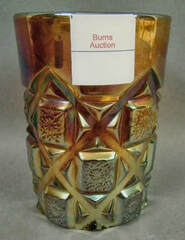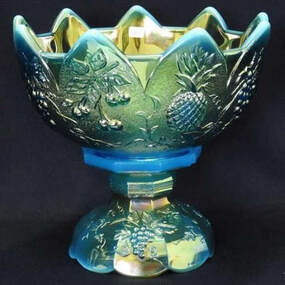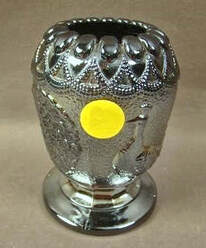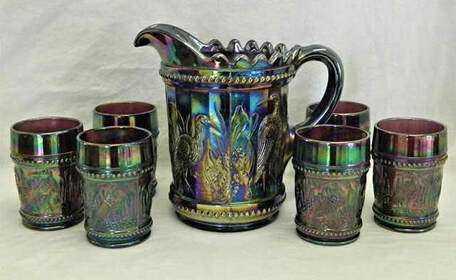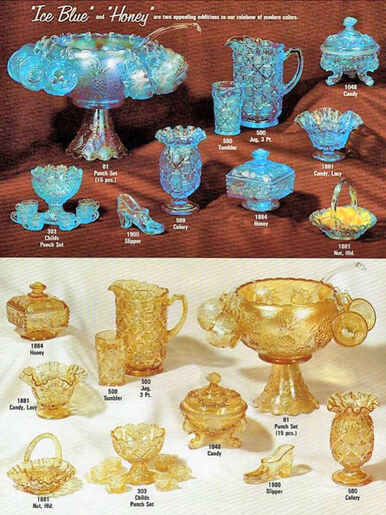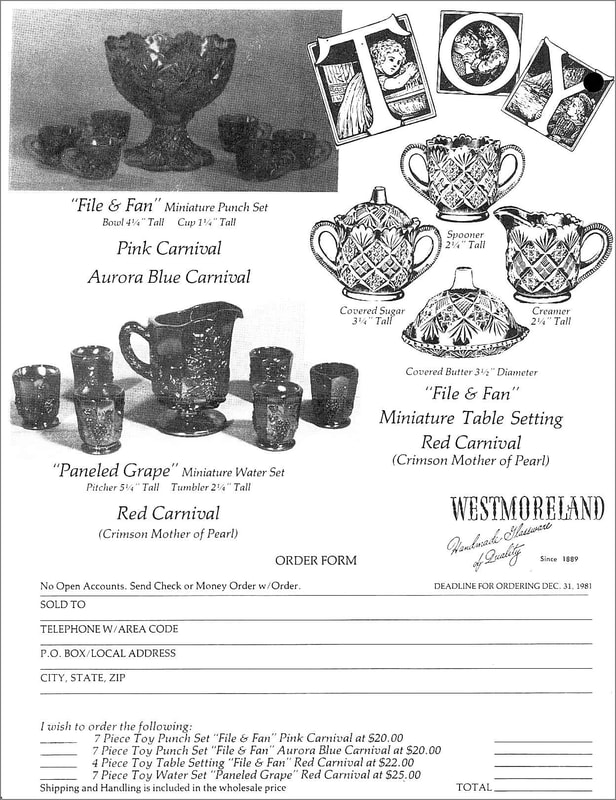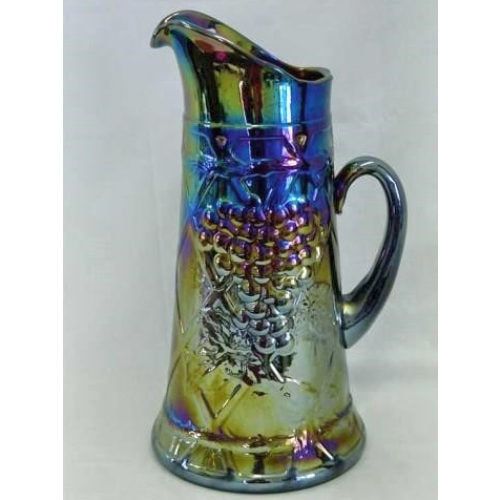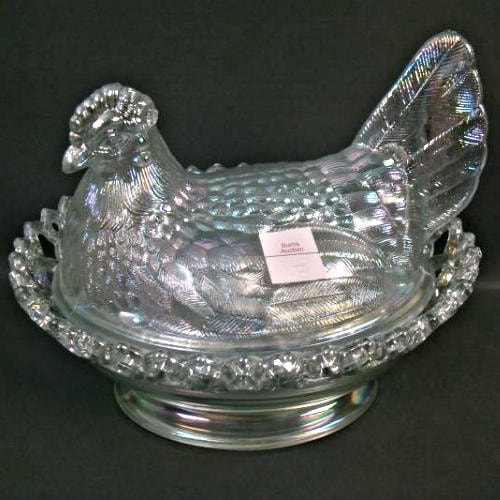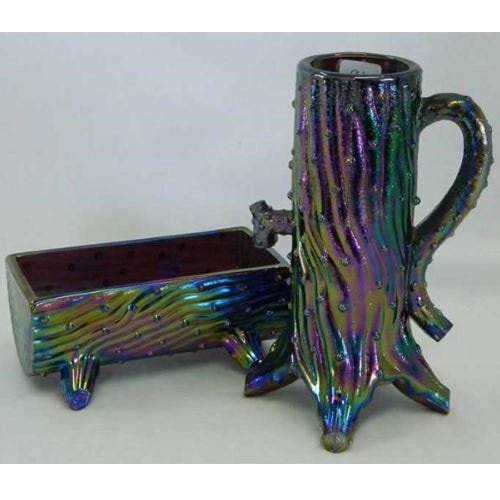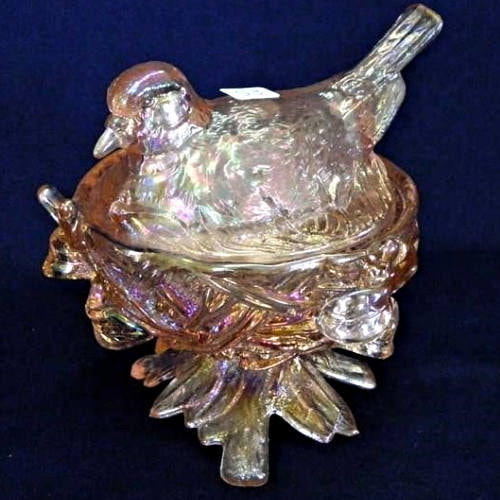Westmoreland's Carnival Revival
Inspired by an article written in 1976 by O. Joe Olson for Dorothy Taylor's "Encore"
with updated and additional material by Glen and Stephen Thistlewood, August 2020.
with updated and additional material by Glen and Stephen Thistlewood, August 2020.
|
A Brief History
Specialty Glass, the forerunner of Westmoreland, began life in 1888, in the small town of Grapeville near Jeannette, PA. It became the Westmoreland Specialty Company in 1889. In February 1925, there was another name change and the business became the Westmoreland Glass Company. Although Westmoreland advertised its (Classic) Carnival Glass as early as 1908 (as we cover later), it was not one of the main producers of iridescent ware. Moving swiftly to the 1950s and 60s, milk glass was very popular and it became an extensive speciality line for Westmoreland for over a decade; old moulds were reused, and new patterns and moulds were added. It was promoted as "America's Finest Handmade Milk Glass" (see right). The 1970s saw the start of Westmoreland's significant involvement in the revival of Carnival Glass production in the USA (the focus of this article). However, by the 1980s, a buyer was being sought for the business. In March 1981, David Grossman (a St. Louis, Mo. based distributor) purchased the company and introduced new lines and new colours. Unfortunately it was not a success and production ceased after the close of business on January 8th, 1984. The stock was sold off, and auctions were held to clear the remaining glass and equipment. There were two fires affecting the empty factory - in January 1996 and then in 1998 - and they brought an end to the Westmoreland Glass Factory forever. Westmoreland's No. 500 Pattern Shown below are two pages from the 1917 catalogue of Westmoreland Specialty Co. showing some of their No. 500 range, known as Old Quilt and also as Checkerboard. At that time, it was being produced in clear/crystal glass in a wide range of shapes, and it became one of their most enduring, long-lived patterns. |
Extract from Westmoreland's 1963 catalogue
Courtesy of Jon D. Bartell |
Above: two pages from the 1917 catalogue of Westmoreland Specialty Company, showing the extensive range of their No. 500 / Old Quilt / Checkerboard pattern. This full range of shapes was made in crystal (clear) glass, but the only shapes that have been reported in Classic Carnival are the tumbler, pitcher and goblet. In the 1950s and 60s, the pattern featured extensively in their milk glass lines, and later still, it reappeared in Contemporary Carnival.
Westmoreland's Classic Carnival
Westmoreland was advertising their "Antique Iridescent" and "Rich Iridescent Ware" as early as 1908-09, but in reality, their range of patterns and shapes offered little competition to the massive outpouring of Carnival that was about to hit the market from Fenton, Imperial, Dugan and Northwood. Although limited in range, Westmoreland's output of Classic Carnival did include some quite unusual patterns, shapes and colours, and indeed some rarities.
Westmoreland was advertising their "Antique Iridescent" and "Rich Iridescent Ware" as early as 1908-09, but in reality, their range of patterns and shapes offered little competition to the massive outpouring of Carnival that was about to hit the market from Fenton, Imperial, Dugan and Northwood. Although limited in range, Westmoreland's output of Classic Carnival did include some quite unusual patterns, shapes and colours, and indeed some rarities.
|
Another Butler Brothers ad for Westmoreland's Classic Carnival. It is from October 1909 and shows a wider range of patterns.
|
A 1908 Butler Brothers ad for Westmoreland's Classic Carnival, showing Orphan Annie sugar and creamer (top, centre) and a range of shapes in the Estate pattern.
|
|
Blue Opalescent is an unusual colour in Classic Carnival. Here are two Westmorland examples.
Left: Fruit Salad punch bowl and base - a very rare item, courtesy Seeck Auctions, and Right: Daisy Wreath bowl. |
Click on the image to visit our
Westmoreland Carnival Glass Gallery (scroll down the page for Westmoreland) |
We have lots of pictures of Westmorelands's Classic Carnival in our Gallery. Click on the image above, right, or here: Westmoreland Carnival Gallery.
Westmoreland's Carnival Glass Revival
Writing in the January 1976 issue of Dorothy Taylor's "Encore" magazine, the well-known Carnival Glass pioneer, writer and researcher, O. Joe Olson, provided a fascinating commentary on Westmoreland's revival of Carnival Glass production which had begun two years earlier, in 1974. Just as with other glassmakers that had originally made Classic Carnival Glass, such as Fenton and Imperial, Westmoreland saw that there was a strong and growing demand for newly produced Carnival (which we now refer to as Revival / Contemporary Carnival). Once again, Westmoreland brought various existing moulds back into production, but they also introduced new patterns and shapes.
Westmoreland had important arrangements with two glass sales/distribution businesses in particular: Levay Glass and L. G. Wright. Items made for these two businesses were often produced in limited editions, in special colours, and with short production runs, to enhance the appeal to collectors.
Note: in the section below, we refer to various Westmoreland items being made in amethyst Carnival, which is the colour they were referred to at the time. Since then, various sources have referred to these pieces as being purple (rather than amethyst).
Writing in the January 1976 issue of Dorothy Taylor's "Encore" magazine, the well-known Carnival Glass pioneer, writer and researcher, O. Joe Olson, provided a fascinating commentary on Westmoreland's revival of Carnival Glass production which had begun two years earlier, in 1974. Just as with other glassmakers that had originally made Classic Carnival Glass, such as Fenton and Imperial, Westmoreland saw that there was a strong and growing demand for newly produced Carnival (which we now refer to as Revival / Contemporary Carnival). Once again, Westmoreland brought various existing moulds back into production, but they also introduced new patterns and shapes.
Westmoreland had important arrangements with two glass sales/distribution businesses in particular: Levay Glass and L. G. Wright. Items made for these two businesses were often produced in limited editions, in special colours, and with short production runs, to enhance the appeal to collectors.
Note: in the section below, we refer to various Westmoreland items being made in amethyst Carnival, which is the colour they were referred to at the time. Since then, various sources have referred to these pieces as being purple (rather than amethyst).
|
Levay commissioned Westmoreland to make pieces using Westmoreland-owned moulds, and also to use some special colours that were limited to Levay. One of Westmoreland's first moves, using their own moulds, was to produce items exclusively for Levay's gift shop in Edwardsville Illinois. These were: "Peacock" pattern lidded creamer and sugar, and a rose bowl (made from the sugar mould) all in in amethyst; Checkerboard cup and saucer in amethyst, 3-piece Child’s Table Set (#299) in amethyst and marigold; Three purple plates - George Washington (pattern #13) in a numbered, limited run of 2500; Cherub Troubadour, now known as Angel and Harp (#19); and Three Kittens (#5). The "Peacock" items (pattern #6) were made from Westmoreland's old Strutting Peacocks moulds. |
Above, left: Westmoreland's Classic Carnival Strutting Peacock creamer and sugar in amethyst, courtesy Seeck Auctions. NB: the lids of these pieces were not iridised.
On the right is a Contemporary Strutting Peacock ("Peacock", #6) rose bowl in purple, made from the old sugar mould. Very few were made. Courtesy Burns Auctions. |
Many years earlier, in 1939, Si Wright (L. G. Wright Glass Co., Marinsville, West Va.) had purchased numerous old Dugan-Diamond moulds, and they had remained unused in a storage area until Wright decided to revive them.
|
In the 1970s Wright Glass commissioned Westmoreland to make reproductions using some of these old moulds, including: God and Home water set in amethyst (the Classic originals were all made in cobalt blue); Dahlia water set in amethyst (the pitcher was the old mould, and tumbler was made from a new mould); Stork and Rushes water set, berry set, and the 3-piece sugar/creamer/spooner table set, all of which were to be made in amethyst and marigold. Maple Leaf 4-piece table set and tumbler in amethyst. Pony plates and bowls in marigold and amethyst. In subsequent years, several of these pieces were made in a range of other colours. Wright also had new moulds made and commissioned Westmoreland to make Contemporary Carnival with them. Contemporary God and Home water set, amethyst. Burns Auctions.
|
Contemporary Maple Leaf table set, amethyst. Burns Auctions.
Contemporary Stork and Rushes water set, amethyst. Seeck Auctions
|
We relate the full story of the God and Home pattern, both Classic and Contemporary here: Collectors Facts - God and Home
|
Also in 1975, Westmoreland, made five or six other items in their ever-popular Checkerboard pattern and also four animal pieces, in amethyst Carnival.
The Checkerboard pieces were: square and round boxes with square finials on lids; tall bowl on pedestal; celery vase on pedestal; and salt and pepper shakers. A few amethyst Carnival cruets in Checkerboard were also made but when problems arose and the effort proved too time consuming, the pressing was discontinued. The animal pieces were: Dolphin-Nautilus 3-footed covered candy dish; solid glass Owl, 5½ inch tall with hand-set eyes; medium-sized Covered Hen; and a Covered Duck, 8½ inch long with hand-set eyes (see below). A few Covered Duck pieces were also made in iridised purple slag with hand-set eyes. Green opalescent pitcher and tumbler in the High Hob, #550 pattern.
Only around 45-50 sets were made. Seeck Auctions. |
Covered Duck. Inset is Westmoreland's mark on the base.
Still in 1975, Westmoreland produced an exclusive order for an Illinois dealer. The pattern was the old favourite, Checkerboard, to be made in two Carnival colours - amethyst and emerald green opalescent (a colour that was said not to have been attempted in Classic Carnival). The shapes made in these two colours were water sets and 4-piece table sets. The amethyst Carnival production went smoothly but Olson reported that there were difficulties in making the green opalescent Carnival. When pressed and taken out of the mould, the glass was a clear emerald green, but when it was reheated, a necessity to bring out the white opalescent effect, and sprayed with the iridescent salts, the glass was too brittle and much breakage followed. The green opalescent run was discontinued: Westmoreland reportedly delivered only some 50 table sets and 45 to 50 water sets. It was said that the dealer was forced to ask a rather high price for these in order to clear the cost of the pressing. Olson quoted the table sets being $80 and the water sets $115. |
Olson had been informed that during the 18 months in which Westmoreland made their new Carnival - that is up to 1976, when he made his report – some 100 different items had been made counting different patterns and base colours. Incredibly, he said that about half of the pieces already were out of production and considered obsolete.
Olson had been informed that during the 18 months in which Westmoreland made their new Carnival - that is up to 1976, when he made his report – some 100 different items had been made counting different patterns and base colours. Incredibly, he said that about half of the pieces already were out of production and considered obsolete.
|
Westmoreland's new Carnival range for 1976 Olson's report provided an important insight into the plans that Westmoreland Glass Co. had for what he called their "second carnival glass era". He reported that they "intended to be a major source of new Carnival Glass in 1976, expanding its lines to offer a total of 40 different items or sets in four distinct iridescent colours": "Honey" - 10 items or sets; pastel ice blue - 15 items or sets; and mother of pearl milk glass - 7 items (with/without "kiln fired" decoration). A Checkerboard water set in "Honey" (a pastel yellow/amber). Courtesy Seeck Auctions.
|
Westmoreland's #1048 in pastel ice blue.
Their Dolphin-Nautilus three-footed covered candy, also called Argonaut, and Seashell & Dolphin. Courtesy Seeck Auctions. Westmoreland called their pastel yellow colour "Honey", and the iridescence was described as a "clear finish with rainbow highlights", using a spray provided by Englehardt Industries of Bayonne, NJ. |
|
The items in the range, illustrated in Westmoreland's catalogue, on the right are: #1884: Beaded Grape covered honey #500: Old Quilt/Checkerboard pitcher, tumbler and celery #81: Multi Fruit 15-piece punch set #1881: Paneled Grape candy & handled nut bowl #1048: Argonaut, aka Dolphin-Nautilus three-footed covered candy #303: File and Fan 7-piece "Childs Punch Set" (more of which below) #1900: Slipper Click on the catalogue image (right) to see the page full size. An impressive display of Checkerboard pieces in pastel ice blue.
Courtesy of Dino Capra. |
Westmoreland's new Carnival range for 1976.
Dorothy Taylor's "Encore" magazine showed part of this in black and white, but we can show it here in full colour. This is a thumbnail image. Click on it to see the catalogue page full size in a new window. |
|
Olson confirmed that Westmoreland's plans for re-entry into the Carnival Glass market also included making some 20 new Carnival items and sets exclusively for various dealers and jobbers. They included an amethyst Paneled Grape water set with the pitcher on a pedestal base, an amethyst 2-handled Cherry and Cable cookie jar, and a child’s 4-piece File and Fan table setting (covered butter, covered sugar, creamer and spooner) in pastel ice blue. Westmoreland made Revival Carnival in a wide variety of colours, shapes and patterns from the mid 1970s through to May 1984 when the business closed. Here on the right is a thumbnail image of Revival Carnival in one of their last catalogues (if not the last one). It shows a range of shapes and unusual "Mother of Pearl" iridescent colours in a single pattern - Wildflower and Lace. Click on the thumbnail to see the catalogue page in full sized detail. After Westmoreland closed, all the assets - including an extensive inventory of moulds - were sold off. See the section below ("Marks and Moulds") for more information on this. |
Wildflower and Lace in Westmoreland's 1984 catalogue. Courtesy of Glass Paper Fanatics. Click on the image to see it full sized.
|
File and Fan miniature sets
"Toy" punch set (aka #303, aka "Thumbelina") This set is sometimes referred to as a "salesman sample", as it was said to be more convenient to carry around than the full sized set. In fact, the miniature set was an "in the line" toy item. Shown below, left is a 1911 ad for the set in crystal (not iridised) - it was clearly described as a toy set. The set was not made in Classic Carnival, but it became a big seller in Contemporary Carnival, and was made in various colours by Westmoreland. Subsequently, the glass wholesaler, Rosso, acquired the mould and had the miniature set made for them in various Carnival and non-Carnival colours. We believe, based on evidence we have seen and also some of the production colours, that Mosser also made this set for Rosso.
|
Above: a Butler Brothers ad from 1911.
Below: a red File and Fan 7-piece "Childs Punch Set".
Westmoreland made this colour in 1979-1981. Miniature 3-piece Child's Table Set, #299
The miniature File and Fan pattern also featured in this 3-piece table set. The set shown here in cobalt blue Carnival was made in around 1978, and some 500 sets were said to have been made in this colour. Miniature 3-piece File and Fan Child's Table set in cobalt blue.
Courtesy of Heather Hansen |
The reference to it being a "salesman sample" was probably due to Westmoreland using the expression as a sales and marketing device. Shown below is a Westmoreland ad from 1983 (shown in Encore Vol 9 No. 1), in which the "Limited Edition Salesman Sample" was the key message in the promotion of this miniature set as a "Unique Collectible".
Miniature 3-piece File and Fan Child's Table set in "Honey".
Courtesy of Burns Auctions |
Westmoreland also made the File and Fan toy punch set for Levay, as this 1981 Levay Promotion leaflet ad shows. The Carnival colours offered were Pink, Aurora Blue and Red / "Crimson Mother of Pearl" - note the higher price for the Red set. Also advertised was the Panelled Grape ("Paneled Grape") miniature water set. Courtesy Glass Paper Fanatics.
Club Commemorative
Many Contemporary Carnival glassmakers saw an opportunity to make commemorative items for the Carnival Glass clubs. As far as we know, Westmoreland only made one club item ... but it is a superb example ... a purple "Buffalo" goblet, made in 1979 for the (now closed) Gateway Carnival Glass Club.
Marks and Moulds
These are three of the ways used by Westmoreland to mark their glass. The first two are moulded in the glass itself, and the third one is a paper label. Not all Westmoreland pieces are marked, and there are no markings on the pieces that Westmoreland made for Wright Glass (from the Wright/Dugan moulds).
These are three of the ways used by Westmoreland to mark their glass. The first two are moulded in the glass itself, and the third one is a paper label. Not all Westmoreland pieces are marked, and there are no markings on the pieces that Westmoreland made for Wright Glass (from the Wright/Dugan moulds).
As a general caveat, after Westmoreland closed in May 1984, the moulds they owned were sold off. Many of them were acquired and used by other glassmakers without always removing the moulded Westmoreland marks immediately. Westmoreland moulds moved on to a number of other companies, including Summit Art Glass, Mosser, Rosso and Fenton (and with the closure of Fenton and the sale of their huge inventory of moulds, the Westmoreland moulds they owned have moved on yet again). Definite attribution to Westmoreland can therefore be very difficult at times.
The Dugan-Diamond moulds owned by Si Wright/L.G. Wright were also sold after that business closed, and many of them were acquired by Fenton. Only a few of them were actually used by Fenton.
More Westmoreland pieces.





